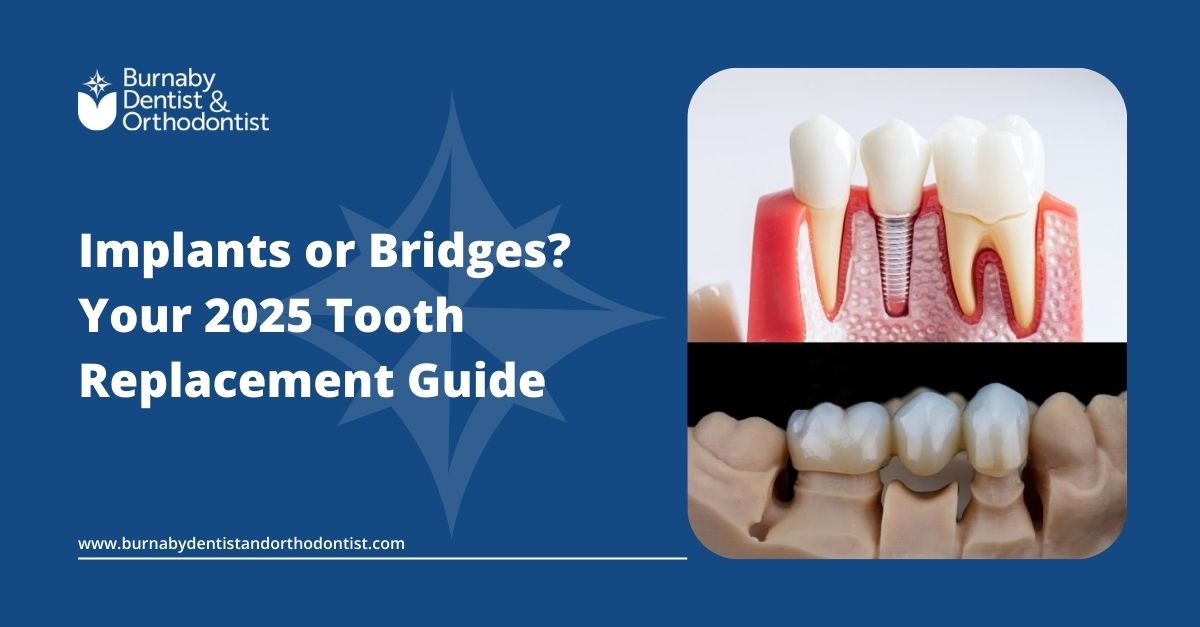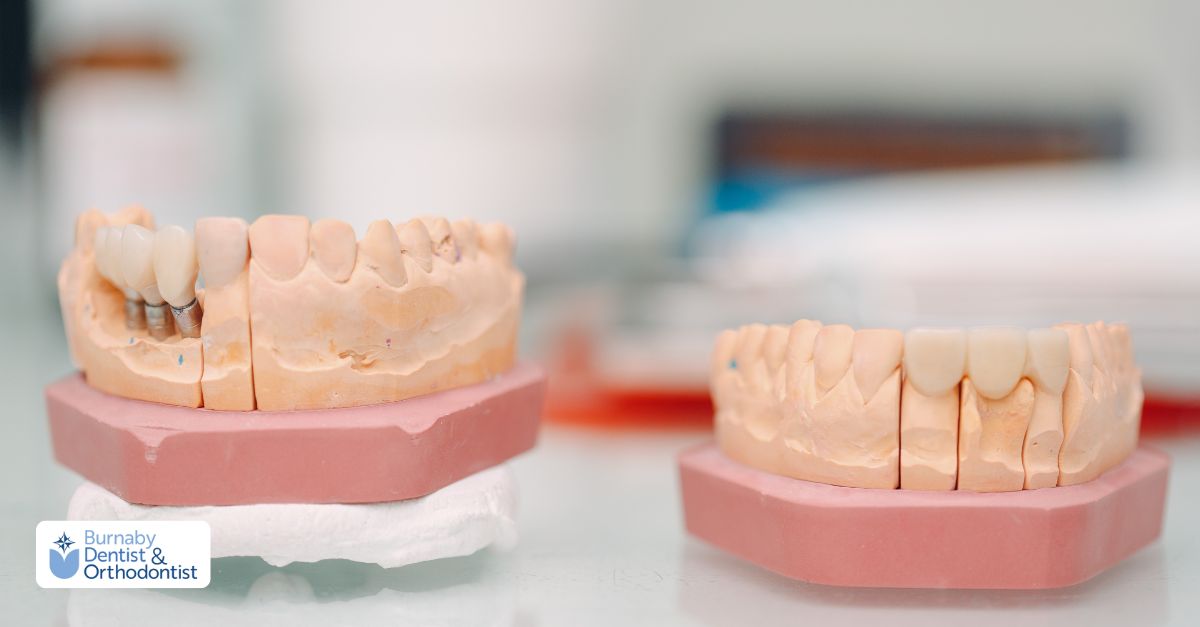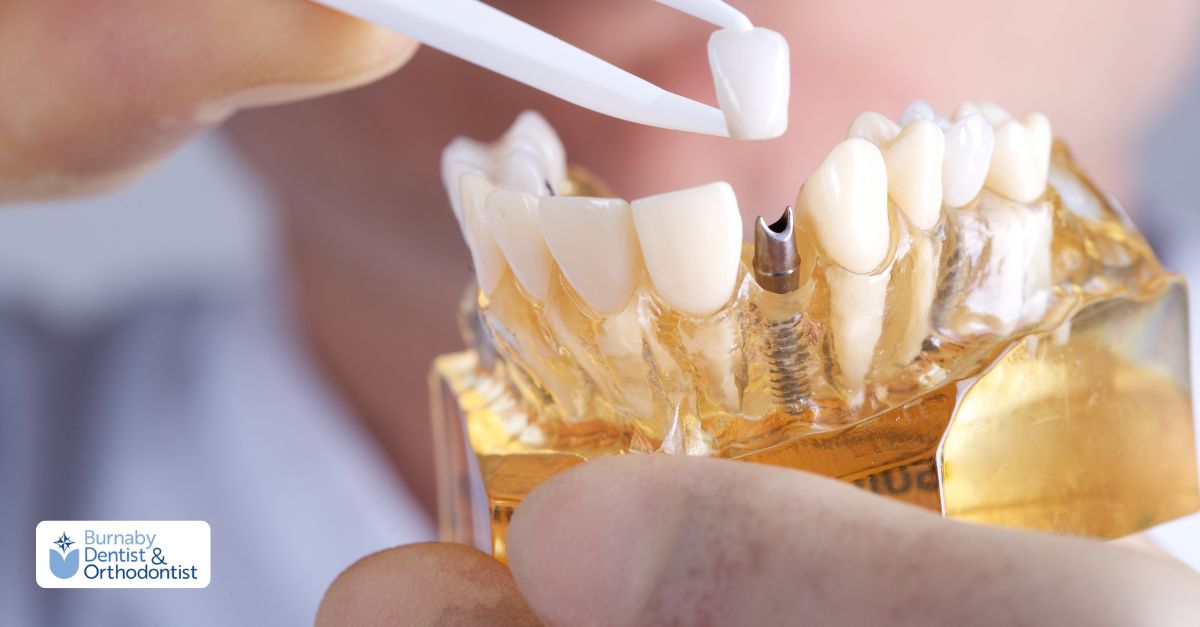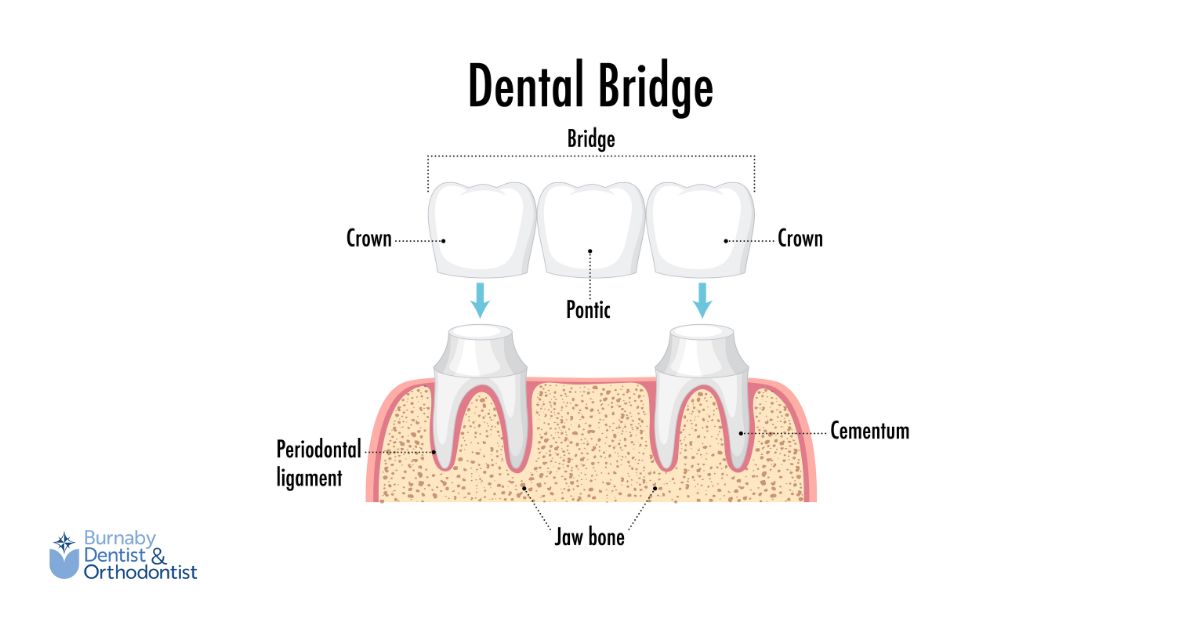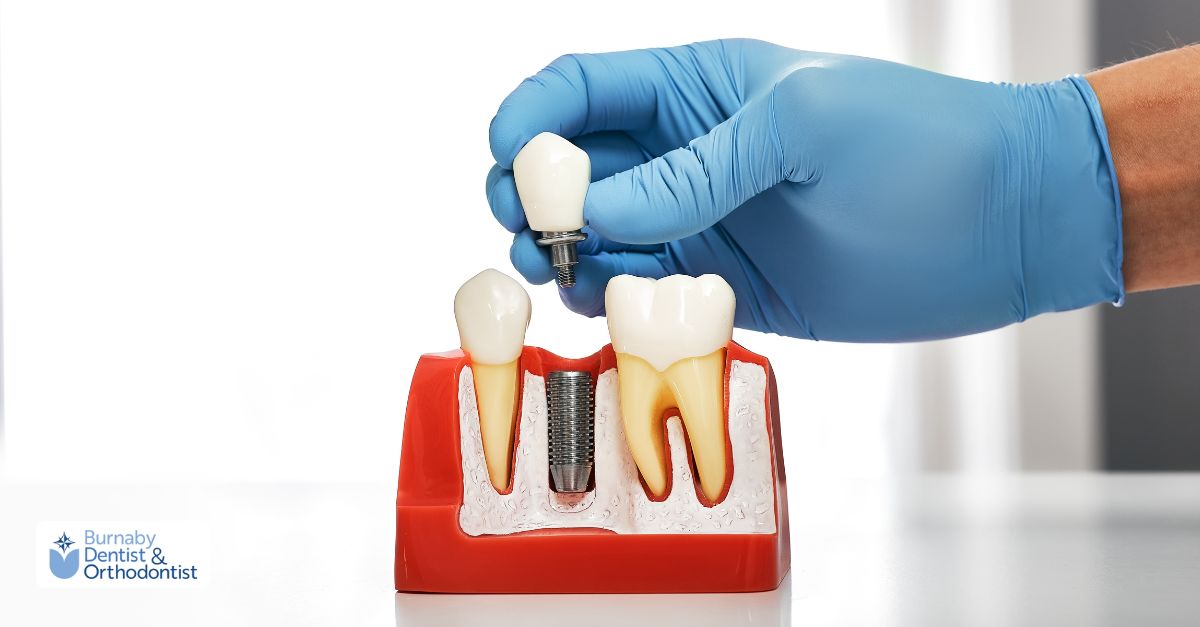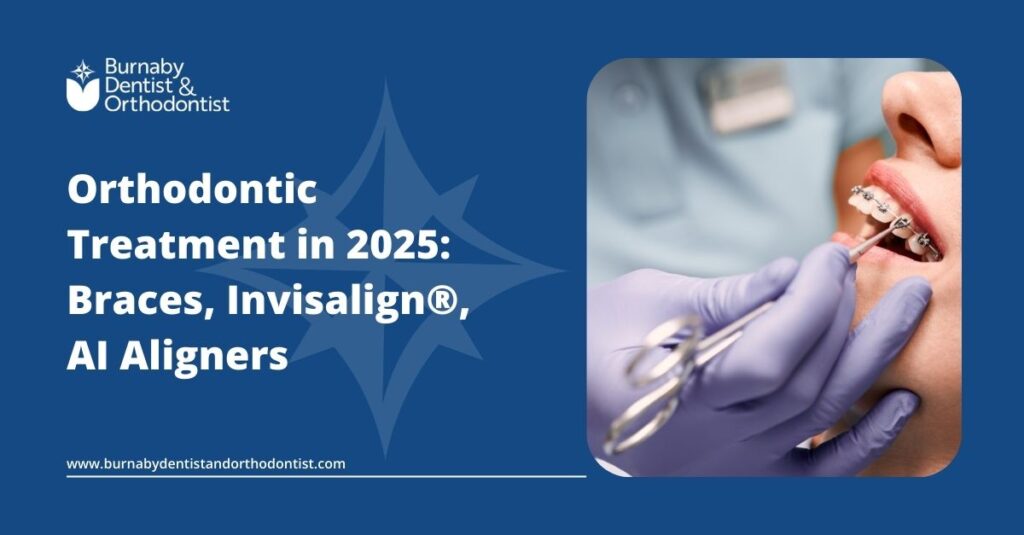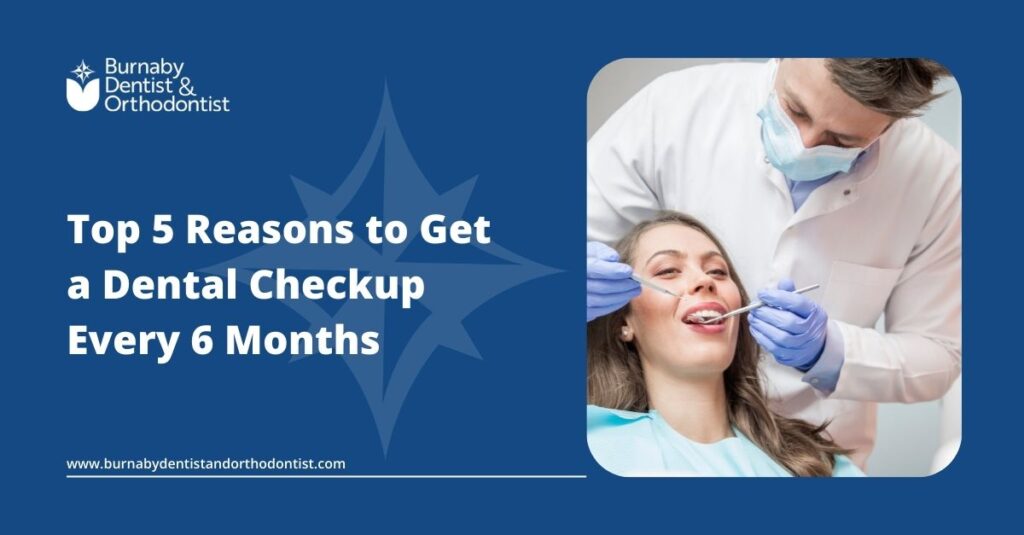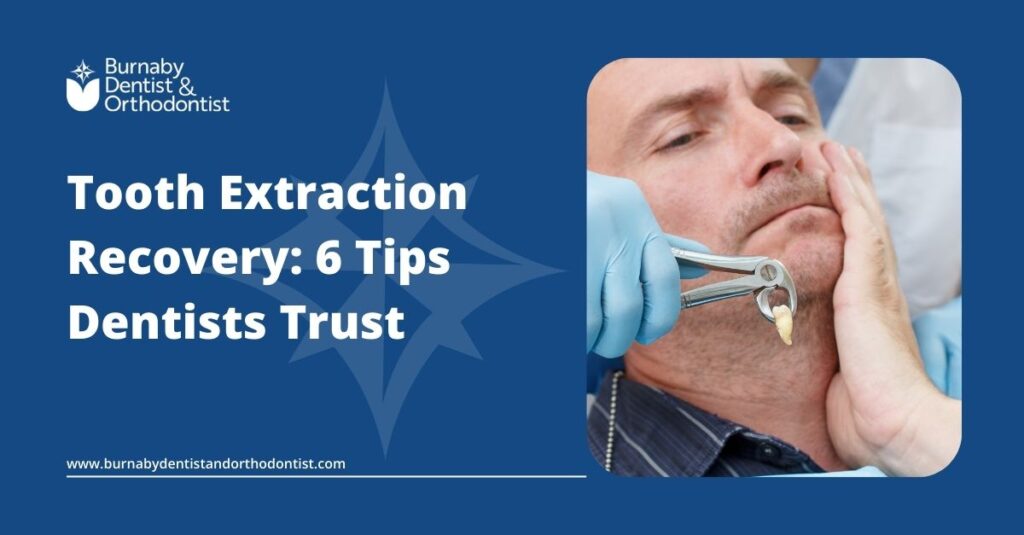Dental bridges fill the gap. Dental implants replace the root. That’s the key difference—and it matters more than ever with the tools available in 2025.
Today’s technology offers more precision, better aesthetics, and longer-lasting results than ever before. But many patients still choose based on outdated comparisons, insurance myths, or assumptions from decades ago.
If you’re replacing a missing tooth, it’s time to look at what modern implant dentistry actually offers—and when a bridge might still be the better fit.
At a Glance:
Dental implants anchor into the jawbone, last 15+ years, and protect bone and neighbouring teeth. Bridges rely on adjacent teeth for support and don’t prevent bone loss, but they offer a quicker, non-surgical option. In 2025, guided digital scans make implants more precise and predictable than ever. At Burnaby Dentist & Orthodontist, we help you choose the right fit for your smile and timeline.
Traditional vs. Modern: Bridges and Implants in Perspective
For many years, dental bridges were the standard way to replace missing teeth. They worked well—restoring function and aesthetics without delay. But while they’re still useful in some cases, modern implant dentistry has shifted the standard of care.
How Bridges Work
A traditional bridge anchors to the teeth on either side of a gap. To place it, those teeth must be reshaped—even if they’re otherwise healthy. Over time, this can lead to weakening, decay, or future dental work on teeth that didn’t originally have problems.
Why Bridges Became the Norm
Before digital planning and implant-supported techniques, bridges were predictable, quick, and widely covered by insurance. For many patients, especially those needing a dental bridge front teeth, they seemed like the safest choice—until the anchor teeth began to fail.
Why Implants Changed the Equation
Dental implants introduced a new option: one that replaces the tooth root itself. Anchored directly into the jawbone, an implant doesn’t rely on other teeth for support. It prevents bone loss, restores bite strength, and functions like a natural tooth.
At Burnaby Dentist and Orthodontist, we use 3D digital scans and guided technology to plan every implant precisely. That means a smoother procedure, faster healing, and long-term results that hold up over time.
Bridges still have a role—but for most patients, implants offer a more durable and biologically sound solution.
How Dental Implants Work in 2025
A dental implant isn’t just a visible replacement—it’s a full structural solution. It replaces the tooth above the gum line and the root beneath it. That’s what sets it apart from bridges, and why it’s considered the gold standard for modern tooth replacement.
The Three-Part Implant Structure
1. Implant Post: Made from medical-grade titanium, the post is placed into the jawbone, where it fuses through a process called osseointegration. This creates a stable foundation for the restoration.
2. Abutment: Once healing is complete, a small connector (the abutment) is placed above the gum line. This links the implant post to your crown.
3. Crown: The crown is the part you see—a natural-looking, custom-made replacement tooth that’s colour-matched and shaped to blend in seamlessly with your smile.
Why Bone Integration Matters
Unlike bridges or dentures, implants stimulate the jawbone by replicating the pressure of a natural tooth. This prevents the bone loss that often follows tooth removal—preserving your facial structure, bite strength, and long-term oral health.
At Burnaby Dentist and Orthodontist, we use digital 3D imaging and guided surgical planning to ensure your implant is placed precisely, with minimal discomfort and maximum longevity.
When a Dental Bridge Still Makes Sense
Dental implants may be the modern gold standard—but that doesn’t mean bridges are obsolete. In the right circumstances, a dental bridge remains a safe, effective, and timely option.
A bridge might be the right fit when:
- The neighbouring teeth already need crowns or restorations. In this case, using those teeth as anchors doesn’t remove healthy structure—it may actually strengthen them.
- You’re not a candidate for surgery. Medical conditions, certain medications, or a preference to avoid procedures might make a bridge the more appropriate path.
- You need a faster solution. If you’re on a tight timeline—whether for work, travel, or personal reasons—a bridge can often be completed in just a few visits.
If you’re considering a bridge, learn practical maintenance that protects your abutment teeth in How to Make Your Dental Bridge Last.
At our Burnaby clinic, we work with patients to understand their health history, lifestyle, and goals before recommending a bridge.
That said, bridges come with limitations:
- If an anchor tooth fails, the whole structure may need to be replaced.
- Cleaning under a bridge requires special flossing tools.
- Bone loss still occurs under the missing tooth—since nothing stimulates the jawbone beneath it.
For these reasons, we use bridges selectively. They’re no longer the default—but they’re still an important part of modern restorative dentistry.
Dental Implants vs. Bridges: Quick Comparison Table
Choosing between an implant and a bridge depends on your goals, oral health, and long-term priorities. Here’s how they compare at a glance:
| Category | Dental Implants | Dental Bridges |
| Bone Health | Stimulates and Preserves Jawbone | Bone Loss Occurs Beneath Missing Tooth |
| Tooth Impact | Doesn’t Affect Neighbouring Teeth | Requires Reshaping Adjacent Teeth |
| Appearance | Natural Look and Gum Contour | May Shift or Show Margins Over Time |
| Cost Over Time | Higher Upfront, Lower Long-Term Risk | Lower Upfront, Potential for More Repairs |
| Oral Hygiene | Clean Like Natural Teeth | Requires Special Flossing Tools |
| Ideal For | Long-Term Health and Bite Stability | Quick Fixes or Non-Surgical Restorations |
| Longevity | 15+ Years With Proper Care | 10+ Years With Good Maintenance |
We’ll guide you through these options in your consultation so you can feel confident in the choice that protects your smile—now and in the future.
Patient Profiles: Which Option Fits You?
There’s no one-size-fits-all answer. The right solution depends on your oral health, personal goals, and how long you want the result to last. These common profiles can help you think through your next step.
One Missing Tooth, Healthy Neighbours → Choose an Implant
If the teeth next to your gap are intact, an implant preserves them. There’s no need to reshape healthy enamel or risk future damage to supporting teeth. The implant also protects bone in the missing tooth site.
Several Missing Teeth in a Row → Consider an Implant-Supported Bridge
When multiple teeth are missing, implants can anchor a longer bridge without involving your remaining teeth. It’s a stable, long-lasting solution that doesn’t sacrifice structure for coverage.
Low Bone or Surgery Isn’t an Option → A Traditional Bridge May Work
Some patients aren’t candidates for implants due to low bone density, medications, or other health concerns. In these cases, a bridge can restore function and appearance quickly—without surgery or grafting.
Need a Faster, Non-Surgical Fix → A Bridge Is Likely Best
If you’re on a short timeline—before a medical procedure, trip, or major event—a bridge can restore your bite faster. It’s often used as a temporary or mid-term solution with the option to plan for implants later.
Want a Long-Term, Bone-Preserving Solution → Dental Implant
If your priority is preserving your jawbone, avoiding future dental work, and getting something that feels truly natural, an implant is often the smarter long-term investment.
Why Choose Burnaby Dentist & Orthodontist for Dental Implants
Replacing a tooth is a long-term decision—and the team guiding you through it matters just as much as the material used.
Here’s what you can expect from us:
✅ Digital Precision, Start to Finish: We use digital dental scans and in-house 3D imaging to plan every step of your treatment. With guided surgery and custom-mapped placement, your implant fits accurately and heals efficiently. No messy impressions. No guesswork.
✅ Plans That Fit Your Life: Your time and comfort matter. Whether you’re replacing one tooth or several, we build a timeline that works with your schedule—not against it. You’ll always know what’s next and why it matters.
✅ Expertise in Complex Cases: Our team has placed hundreds of implants—from single-tooth replacements to full-arch restorations. We’re also experienced in treating patients with bone loss, medical conditions, or failed bridges. If your case needs extra planning, you’re in good hands.
✅ Care That Goes Beyond the Procedure: Your follow-up matters as much as your surgery. We provide clear hygiene instructions, maintenance visits, and ongoing support to keep your implant strong for the long term.
Let’s make your next step the right one. At our Burnaby clinic, we combine modern tools with a commitment to care—because your result should feel natural and last.
Conclusion
Replacing a missing tooth isn’t just about filling a gap—it’s about making a long-term decision for your health, function, and confidence.
Dental implants offer stability, preserve your jawbone, and protect nearby teeth. Bridges still have their place, especially when speed or non-surgical options are priorities. The best solution depends on your goals, health, and timeline.
As the Burnaby dentist, we guide you through the decision with digital precision, honest insight, and supportive care—every step of the way.
Ready to explore your options with clarity and confidence? Book your consultation today. We’ll help you choose what’s right for you, not just what’s familiar.

